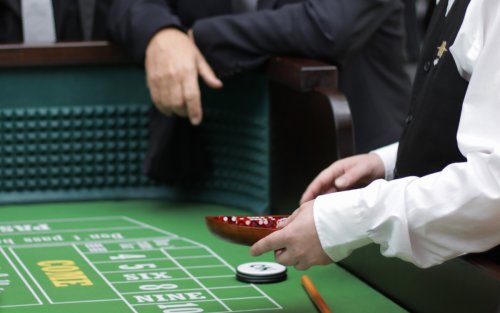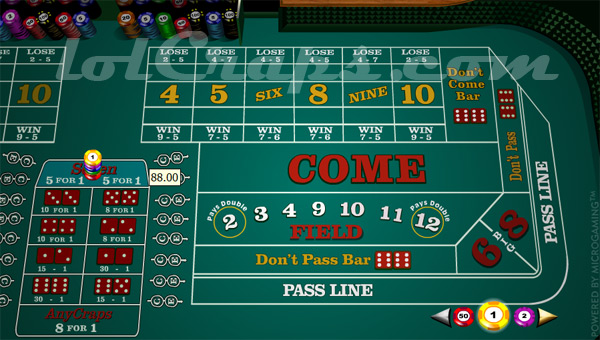- Virtually every craps game has a maximum bet ranging from $2,000 and up. Most of them are $10,000 or less. That means in the unusual but very possible case of someone going 25 rolls without a 7, this player is out his entire investment of over $20,000 and he cannot continue.
- Some Craps players refer to don’t passline bets as “betting wrong,” and consequently, a passline bet is called “betting right.”. When you make a passline bet, you are betting to roll a 7 or 11 on the first roll.
The Any Seven bet has to be the simplest bet type one can place at the craps table but is less popular among players for a number of reasons.
If a 7 comes before the point, the Pass Line loses. Don't Pass - This is the opposite of betting the Pass Line. The bet wins on a 2 or 3 on the first roll. It loses on a 7 or 11. A 12, which is the house roll, is a push. A 4, 5, 6, 8, 9, or 10 becomes the point. The Don't Pass wins if a 7 is rolled before the point.
It is considered a higher-risk wager because it is a single-roll bet. What's more, the casino's built-in advantage for Any Seven bets is quite substantial, especially when compared to less hazardous basic bets the likes of Pass/Don't Pass and Come/Don't Come.
CasinoCruise
 Sign Up
Sign Up100% up to
$/€100
Royal Panda
Sign Up100% up to
$/€200
+ 10 Spins
Vegas Hero Casino
Sign Up100% up to
€200
+ 50 Spins
Casoo Casino
Sign Up100% up to
$/€300
+ 100 Spins
The soaring house edge attached to Any Seven bets can be attributed to the fact seven is the number where most combinations and permutations are possible, making it more likely to get rolled. Nevertheless, some more experienced craps players choose to strategically incorporate the Any Sevens into their bet pattern.
Read on for more detailed information of the Any Seven bet and its odds.
The Any Seven Bet Explained
Any Seven is among the most known bet types in the game of craps. The wager is often announced at the table by its nickname, “The Big Red”.
Any Seven is a one-roll bet and is placed not by players themselves, but by the stickman. The area where the chips for this bet are stacked is located at the center of the table's layout. As the name of the wager itself suggests, players are betting that the very next throw of the dice will result in the number 7 being rolled. No come-out rolls are required when placing Any Seven bets. The latter can be placed at all times.
In other words, the next throw of the dice determines whether players win or lose. It matters not which of the possible combinations adds up to seven, either way, your Any Seven bet will win. However, if any other number apart from seven is rolled, your Any Seven bet will respectively lose.

That's basically all there is to it, however, players are advised to steer clear of Any Seven bets as they have a massive built-in casino advantage to them and might cause bettors to lose money very quickly. More on this in the next section.
Odds for the Any Seven Bet
As was already mentioned, Any Seven bets have a high house edge that works to players' disadvantage, even if they are winning.
Let's proceed by explaining why this is so.
As becomes apparent by the dice combinations chart, seven has the highest number of possible combinations that add up to its total. Since the game of craps is played with two dice, there are six combinations to add up to seven, respectively 1-6, 6-1, 2-5, 2-5, 3-4 and 4-3. There are 36 possible combinations for the numbers from 2 to 12. This indicates the chances of rolling the number seven are 6 out of 36. There are 6 possible ways to win versus 30 different ways to lose. Indeed, the number 7 tends to get rolled most frequently.
From this, it follows the “true” odds for Any Seven bets dictate these should be paid out at a rate of 5 to 1.
Craps Seven
However, the payout for Any Seven bets is listed at the table layout as 5 for 1.
The wording here is of crucial importance as the use of the preposition “for” indicates you will be paid $4 in exchange for a $1 bet instead of $5 per each $1 winning wager as the “true” odds demand. So, it turns out players are actually paid 4 to 1 provided their Any Seven bets win. This will result in you actually losing money in the long run, even if you are winning as Any Seven bets go hand in hand with an impressive house edge amounting to about 16.67%!
This percentage translates into a $16.67 loss for every $100 you spend on Any Seven bets.
Conclusion

Seasoned craps players have come to the conclusion Any Seven is the least profitable bet one can place in this dice game. It boasts the highest built-in advantage for the casino and is to be avoided, especially by craps novices who still have not established a betting pattern that works to their advantage.

Since these are single-roll bets, they are largely considered more suitable for high-rollers who prefer to go for high-risk bets with better payouts. The only advantage of Any Seven bets stems from the fact wagers below the table's minimum are accepted. However, inexperienced players are recommended to stick to the basic bet types like the Pass/Don't Pass and the Come/Don't Come which have a smaller house edge but pay even money.
Related Articles
Related News
Craps Any Seven Strategy
